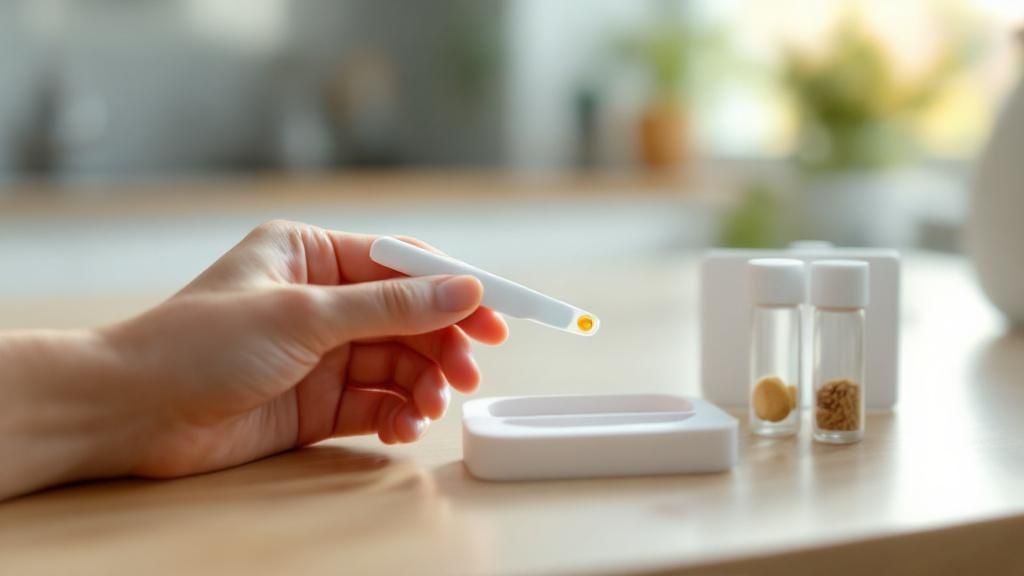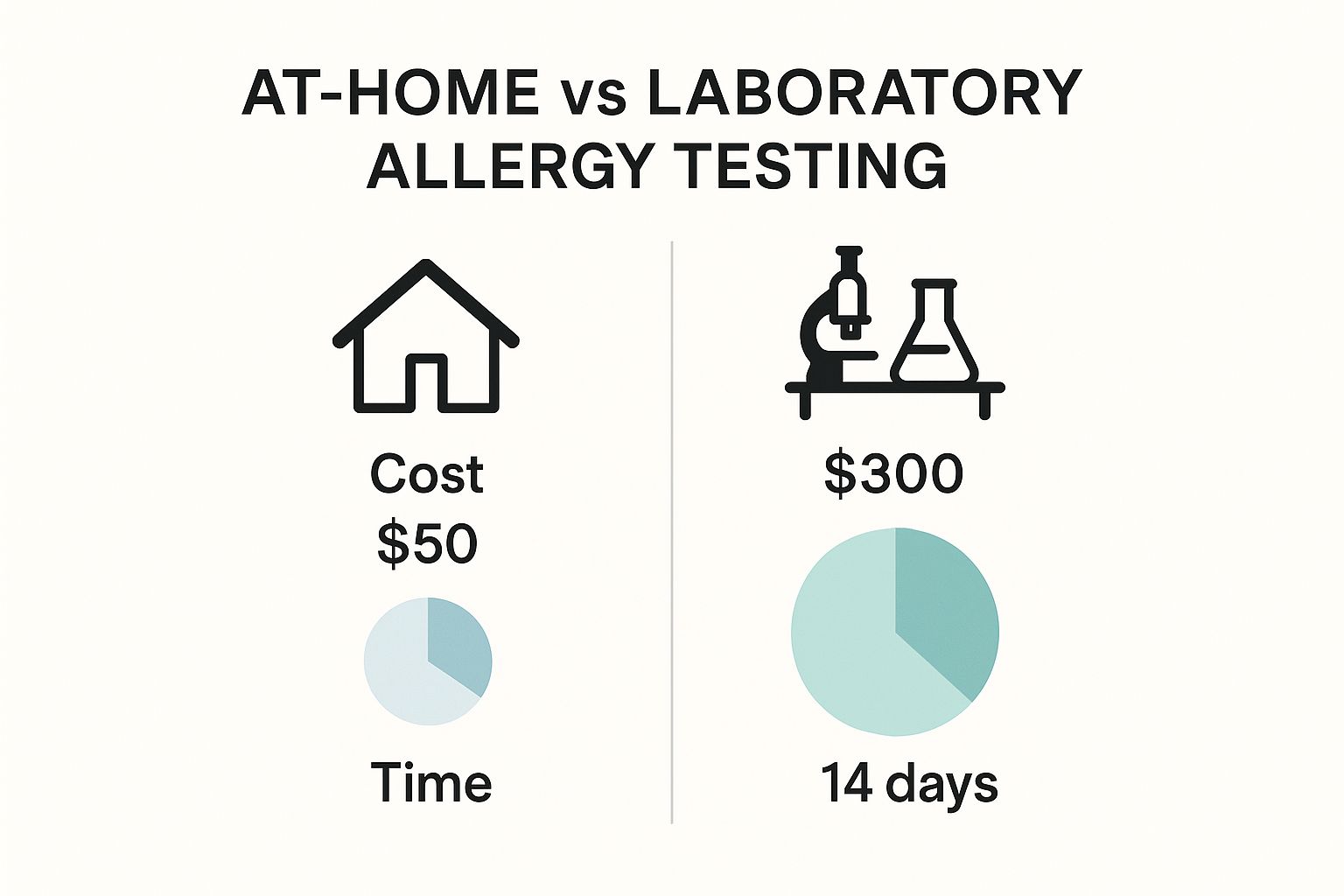
Constant sneezing, itchy eyes, or that nagging feeling after a meal—could it be an allergy? For years, getting answers meant scheduling a doctor's visit, waiting for an appointment, and heading to a clinic. But now, you can start investigating potential triggers right from your own home.
At-home allergy testing offers a convenient, modern first step to understanding what’s really going on with your body. These kits, like the BARB N.P. Environmental and Food Allergy IgE Test, typically use a simple finger-prick blood sample that you collect yourself and mail to a lab, giving you a preliminary look at potential sensitivities without ever leaving the house.
Your First Look At-Home Allergy Testing
Think of your immune system as your body's personal security team. Its main job is to identify and fight off real threats, like viruses or bacteria. But sometimes, it gets its wires crossed and flags a totally harmless substance—like pollen, peanuts, or pet dander—as a dangerous invader.
When this overreaction happens, your body produces specific antibodies called Immunoglobulin E (IgE) to "tag" that substance for future attacks. These IgE antibodies are exactly what most at-home allergy tests are designed to find.
The process is refreshingly simple:
- You order a kit online, like the easy-to-use panels offered by BARB N.P.
- You use a tiny, sterile lancet to collect a few drops of blood from your fingertip. No big needles involved.
- You pop the sample into a prepaid mailer and send it off to a certified laboratory.
- The lab analyzes your blood for the presence of IgE antibodies linked to a wide range of common allergens.
If the test comes back positive for a certain substance, it means your body is "sensitized" to it. This isn't a formal diagnosis just yet, but it's a huge clue that helps guide the conversation when you do speak with a healthcare professional.
Convenience Meets Preliminary Insight
The biggest draw of at-home testing is its sheer accessibility. It cuts out the travel, the waiting rooms, and the scheduling headaches, making it incredibly easy for anyone to take that first step. It puts the power back in your hands.
And people are catching on. The global market for at-home allergy test kits was valued at around $500 million in 2025 and is expected to skyrocket to $1.8 billion by 2033. This boom is driven by a greater awareness of allergic conditions and kits that are becoming more user-friendly every day. You can read more about the home allergy testing market trends and see just how much convenience is shaping modern healthcare.

As you can see, at-home kits often deliver results much faster and at a lower cost, making them a fantastic starting point for anyone looking for answers. The BARB N.P. Food Allergy Test, for example, provides a comprehensive look at common food triggers without the need for a clinic visit.
To help you decide which path is right for you, let’s break down the key differences between testing at home and going to a clinic.
At-Home vs Professional Allergy Testing
| Feature | At-Home Allergy Test | Professional Allergy Test (In-Clinic) |
|---|---|---|
| Method | Finger-prick blood sample (IgE) mailed to a lab. | Skin prick test or blood draw (IgE) performed by a clinician. |
| Convenience | Highly convenient; done entirely from home on your own schedule. | Requires scheduling an appointment and visiting a clinic or lab. |
| Cost | Generally more affordable, with one upfront cost for the kit. | Can be more expensive; may involve consultation and testing fees. |
| Speed of Results | Typically faster, with results often available online in days to a week. | Can take longer, depending on lab processing and follow-up appointments. |
| Scope | Tests for a pre-set panel of common food and environmental allergens. | Can be customized by the allergist to test for specific suspected allergens. |
| Interpretation | Results provide data on sensitization, requiring professional interpretation. | Results are interpreted immediately by a specialist in context of your history. |
| Best For | Initial screening, identifying potential triggers, and gathering preliminary data. | Definitive diagnosis, complex allergies, and creating a formal treatment plan. |
Ultimately, at-home tests are an empowering first step, but a professional's expertise is essential for putting the puzzle pieces together.
Keep in mind: At-home tests are a screening tool. They are brilliant for identifying sensitization, but a true clinical allergy diagnosis requires a healthcare professional to interpret these results alongside your specific symptoms and medical history.
How At-Home Allergy Tests Actually Work

So, you’ve mailed in your sample. What happens next? The journey from a few drops of your blood to a detailed report is a fascinating process that zeroes in on the tiny defenders responsible for your body's overreactions. It all comes down to the science of antibodies.
At the heart of it all are Immunoglobulin E (IgE) antibodies. Think of them as your immune system’s highly specialized security guards. When your body mistakes a harmless substance—like peanut protein or dust mites—for a genuine threat, it creates specific IgE antibodies designed to recognize and "tag" that one particular substance for attack.
This means if you're allergic to cats, you have cat-specific IgE antibodies floating around. If grass pollen is your trigger, you have grass pollen-specific IgE antibodies. An at-home allergy test is designed to measure the levels of these specialized antibodies in your bloodstream.
From Your Fingertip to the Laboratory
The path your sample takes is a precise and carefully controlled one, starting with that simple finger prick. It’s far less intimidating than a traditional blood draw, and what follows is a sophisticated analysis.
- Sample Collection: You collect a few drops of blood on a special collection card or in a small vial. This tiny sample contains all the IgE antibodies the lab needs to get to work.
- Lab Analysis: Once it arrives, lab technicians expose your blood sample to a panel of different common allergens—things like various foods, pollens, molds, and pet dander.
- The Binding Reaction: If your blood contains IgE antibodies for a specific allergen (let's say, shrimp), those antibodies will immediately bind to the shrimp protein on the test panel. It’s like a perfect lock-and-key fit; only the correct antibody will connect with its matching allergen.
- Measuring the Response: The lab then uses advanced technology to measure the amount of IgE that has latched onto each allergen. A higher level of a specific IgE indicates a stronger "sensitization" to that substance.
This entire process provides a clear, quantitative result for every allergen tested, revealing which ones your immune system has flagged as potential troublemakers.
Key Insight: A positive result on an allergy test indicates sensitization, which means your body has produced IgE antibodies to a substance. This doesn't automatically guarantee you'll have a severe allergic reaction, but it's a critical piece of the puzzle.
The Critical Difference: IgE vs. IgG Tests
As you explore at-home testing, you'll likely come across two types of antibody tests: IgE and IgG. It is crucial to understand the difference, as they measure entirely different immune responses.
The medical community universally recognizes IgE testing as the gold standard for identifying true allergies. These are the rapid-response reactions that cause immediate symptoms like hives, swelling, and breathing issues. Reputable tests, like those from BARB N.P., focus on these clinically significant IgE antibodies to provide you with actionable insights.
On the other hand, you might see IgG tests, often marketed as "food sensitivity" or "food intolerance" tests. These measure Immunoglobulin G antibodies. The problem is, the presence of IgG is generally considered a normal immune response to food exposure.
Most major allergy and immunology organizations do not recommend IgG testing for diagnosing food allergies or sensitivities. A high IgG level for a particular food might just mean you eat that food often, not that you're intolerant to it. By sticking to scientifically validated IgE testing, you ensure the information you receive is directly relevant to identifying potential allergies and can genuinely guide your health decisions with your doctor.
Finding the Right At-Home Allergy Test

So, you’ve decided to take the first step with an at-home allergy test. That’s great. But once you start looking, you’ll quickly realize not all kits are created equal. The key is to match the test to your symptoms. Think of yourself as a detective—you need the right tools to follow the right clues.
The world of potential allergens is huge, but most at-home tests wisely break them down into two main groups. Figuring out which group your symptoms fall into is the most important first step.
Environmental vs. Food Allergy Panels
First up are environmental allergens. These are the culprits you breathe in or touch in your everyday surroundings. If you start sneezing the moment spring arrives or get itchy eyes every time you visit a friend with a cat, an environmental panel is where you should start your investigation.
These tests screen for the usual suspects floating around in the air, including:
- Pollens: From grasses, weeds, and trees that can make certain seasons miserable.
- Pet Dander: Tiny proteins from the skin, saliva, or urine of cats and dogs.
- Dust Mites: Microscopic critters that love to live in bedding, carpets, and furniture.
- Molds: Spores that can pop up in damp areas around the house.
The second category is food allergens. These tests are for anyone who suspects a link between what they eat and symptoms like hives, an upset stomach, or that weird tingling feeling in your mouth after a meal. This is how you can investigate common dietary triggers behind your discomfort.
Here’s the deal: A good at-home test won't throw hundreds of obscure allergens at you. It will focus on a curated panel of the most common triggers, so you can zero in on what’s most likely causing your issues without getting overwhelmed. The BARB N.P. Environmental and Food Allergy IgE Test offers a comprehensive panel that covers both categories for a broader initial screening.
Comprehensive vs. Targeted Testing
Beyond the food versus environment split, tests also differ in how broad they are. Some kits offer comprehensive panels that check for a wide range of substances all at once. This is a fantastic option if your symptoms are vague and persistent, and you honestly have no idea where to even begin looking.
Other kits are more targeted, focusing on a smaller, specific group of allergens. For example, if your symptoms only ever show up after you eat, you probably don’t need to test for dozens of different pollens. A focused food panel is a smarter, more cost-effective choice.
This is where a little self-awareness goes a long way. A targeted test helps you narrow down specific suspects, while a broad panel casts a wider net to catch culprits you might not have considered.
A Real-World Example: BARB N.P. At-Home Tests
To make this less abstract, let’s look at the BARB N.P. line of at-home tests. They are designed to be straightforward, offering specialized panels that make it easy to choose the right option for you. Plus, their kits are built on the scientifically validated IgE antibody testing method, so you can trust the preliminary data you receive.
For instance, if you’re pretty sure your diet is the problem, you can explore the in-depth BARB N.P. food allergy test, which screens for common triggers like dairy, wheat, soy, peanuts, and shellfish. The whole process is user-friendly, guiding you from the simple finger-prick sample collection all the way to understanding your results online.
Choosing the right at-home allergy test really comes down to matching the kit to your personal health mystery. By figuring out whether your symptoms point to your environment or your plate, you can select a test that gives you the most valuable insights to bring to your healthcare provider.
A Realistic Look at Test Accuracy and Limits

Getting your at-home allergy test results back can feel like a lightbulb moment. But before you overhaul your diet or clear out your pantry, it's critical to understand what these results really mean. The most important conversation we can have about allergy testing at home is about accuracy and its built-in limitations.
Think of these tests as powerful screening tools, not a final, definitive diagnosis. Their job is to identify sensitization—the presence of specific IgE antibodies in your blood. In simple terms, sensitization means your immune system has noticed a substance and created a "wanted poster" for it.
But here’s the key: just because that poster exists doesn't mean you'll have a full-blown allergic reaction every time you encounter that substance. This distinction is crucial for setting realistic expectations.
Understanding False Positives and Negatives
No test is perfect, and at-home allergy tests are no exception. Their accuracy is often discussed using two terms: sensitivity (how well a test finds true positives) and specificity (how well it finds true negatives).
Top at-home test providers report accuracy rates between 70% and 90% for identifying sensitization. While that’s impressive, it also leaves room for error.
- False Positive: The test flags you as sensitized, but you don't actually react to the substance. This can happen with things like cross-reactivity, where proteins in birch pollen look similar to proteins in an apple, confusing your immune system.
- False Negative: The test says you're in the clear, but you do have an allergy. This is less common but can happen if the IgE levels in your blood were too low to be detected when you took the test.
Because of this, making drastic lifestyle changes—like cutting out entire food groups—based solely on these results isn't recommended without a professional’s guidance.
Your at-home test results are a valuable starting point for an informed conversation with your doctor. They are not the final word. Always discuss your findings with a healthcare professional who can put them into the context of your symptoms and medical history.
The Bigger Picture of Allergy Diagnostics
The buzz around at-home testing is part of a much larger trend. The global allergy diagnostics market was valued at about $6.54 billion in 2024 and is projected to hit $11.63 billion by 2030. This incredible growth is fueled by the sheer number of people affected by allergies—over 50 million Americans suffer from them every year.
This data shows a massive need for more accessible ways to investigate potential allergies. While a clinical workup remains the gold standard for diagnosis, at-home kits are filling an important gap by providing initial insights, conveniently and affordably.
From Data Points to Diagnosis
Your test results are just a set of data points. A diagnosis, however, is a clinical conclusion that only a healthcare provider can make after looking at the complete picture.
Here's what an allergist or doctor will do:
- Review your at-home test results.
- Take a detailed personal and family medical history.
- Discuss your specific symptoms—what happens, when, and how severely.
- Perform a physical exam.
- Order further clinical testing, if needed, to confirm or rule out an allergy.
This methodical approach ensures that any treatment plan or dietary change is based on a full understanding of your health. When you're ready to start that conversation, a comprehensive option like the BARB N.P. Environmental and Food Allergy IgE Test provides a robust set of data to bring to your provider.
When You Should See a Doctor About Your Allergies
Think of an at-home allergy test as the first chapter in your health story. It gives you incredibly valuable clues about potential triggers, but it’s not the final word. The real power of allergy testing at home comes when you take that information and have a smarter, more focused conversation with a healthcare professional. A doctor provides the clinical diagnosis that turns your data into a clear action plan.
Knowing when to book that appointment is crucial. While you might be able to handle mild, occasional sniffles on your own, certain red flags are your body’s way of saying it’s time for an expert. Ignoring them can mean dealing with worsening symptoms or just plain unnecessary misery.
Recognizing Critical Symptoms
Some symptoms are more than just an annoyance—they’re a clear signal to get professional medical help right away. If you experience any of the following, it’s time to call your doctor or an allergist.
- Severe Reactions: This is a big one. Any sign of anaphylaxis—a life-threatening reaction that can cause breathing difficulties, a swollen throat or tongue, a racing pulse, dizziness, or fainting—requires immediate medical attention.
- Breathing Difficulties: Don’t ignore persistent wheezing, coughing, shortness of breath, or a tight feeling in your chest. These can be signs of allergic asthma, a serious condition that needs a doctor's care.
- Chronic and Disruptive Symptoms: Are your symptoms getting in the way of your life? If constant nasal congestion, sinus headaches, skin rashes, or digestive problems are messing with your sleep, work, or daily routine, it's time for an expert opinion.
These situations are non-negotiable. An allergist can run tests in a medically supervised setting and prescribe emergency treatments, like an EpiPen, if you need one.
The Allergist's Deeper Investigation
When you see a specialist, they do more than just glance at a test result. An allergist is like a detective, piecing together multiple clues to get a complete and accurate picture of what’s going on with your health.
An at-home test gives you a list of potential suspects. An allergist conducts the full investigation, combining your test results with your personal history and a physical exam to pinpoint the real culprit and create a targeted treatment plan.
Their approach is both methodical and personal. It usually starts with a detailed conversation about your medical history, followed by a thorough physical exam. They may also recommend further clinical-grade testing to confirm what your at-home kit suggested. This deep dive ensures that any treatment or lifestyle change is perfectly tailored to you.
The demand for this kind of specialized care is growing fast. The U.S. allergy diagnostics and therapeutics market was valued at around $10.88 billion in 2024 and is expected to shoot up to $21.20 billion by 2034, with inhaled allergens being a major driver. You can discover more insights about the expanding U.S. allergy market to see the full picture.
When you walk into your appointment with your at-home test results, like those from a BARB N.P. kit, you change the entire conversation. You're no longer just someone describing vague symptoms; you’re an informed partner, armed with preliminary data that helps your doctor get to the root of the problem faster and puts you on the quickest path to feeling better.
Your Questions, Answered
Taking the first step into at-home allergy testing is a big move toward understanding your body, but it’s totally normal to have a few questions before you dive in. You know how they work and what they look for, but what about the nitty-gritty details?
Let's clear up the most common questions. Think of this as your quick-start guide to feeling confident about the entire process, from that first finger prick to figuring out what your results really mean.
Is the Finger-Prick Test Painful?
This is probably the number one concern we hear, and the good news is, it’s designed to be quick and almost painless. At-home allergy kits use a tiny, sterile device called a lancet that gives your finger a quick poke.
Most people say it feels like a brief pinch that’s over in a second—less intense than a mosquito bite and way less intimidating than a traditional blood draw at a clinic. The whole point is to make it simple and comfortable enough to do yourself.
How Long Until I Get My Test Results?
I know waiting for answers is the hardest part. Luckily, the turnaround time is pretty quick. Once you collect your sample and pop it in the mail using the prepaid package, the lab gets right to work.
You can typically expect your digital results within one to two weeks from the time the lab receives your sample. Your kit's instructions will always give you a specific timeframe, and brands like BARB N.P. send your detailed report straight to a secure online portal, making it easy to access.
Key Takeaway: The entire process is built for convenience. From a simple sample collection at home to fast digital results, you can get the information you need to start a productive conversation with your doctor much sooner.
Can At-Home Allergy Tests Be Used for Children?
This is such an important question for parents trying to get to the bottom of their child's symptoms. The answer really comes down to the specific test kit. Most at-home allergy tests are designed and validated for adults aged 18 and older.
For safety and accuracy, there are often strict age limits. Before buying a kit for anyone under 18, it's absolutely critical to read the product guidelines. When it comes to a child’s health, the best and safest path is always to consult with their pediatrician or an allergist for proper diagnosis and care.
What Is the Best Way to Use My Results?
Getting your results is an exciting moment, but it’s crucial to understand what they are: a valuable starting point, not a final diagnosis. The most important next step is to discuss your results with a qualified healthcare provider.
Your doctor or allergist can interpret the data within the full context of your health, looking at your specific symptoms and medical history alongside the test report. This is how you confirm if a clinical allergy truly exists.
It's vital that you never make drastic dietary changes, like cutting out an entire food group, based only on at-home test results. Doing so without medical supervision can lead to nutritional deficiencies or even mask other health issues. Instead, use your results to have a more focused, productive conversation with a professional who can create a safe and effective plan for you. Exploring the different types of BARB N.P. allergy tests can help you choose the panel that will arm you with the best information for that appointment.
This approach ensures you’re using at-home testing responsibly—turning data into a clear path toward better health.
Ready to take control and understand your body's triggers? The BARB N.P. at-home allergy tests offer a convenient and reliable way to gather the insights you need. Explore our scientifically validated IgE antibody tests today and start your journey toward clarity.

